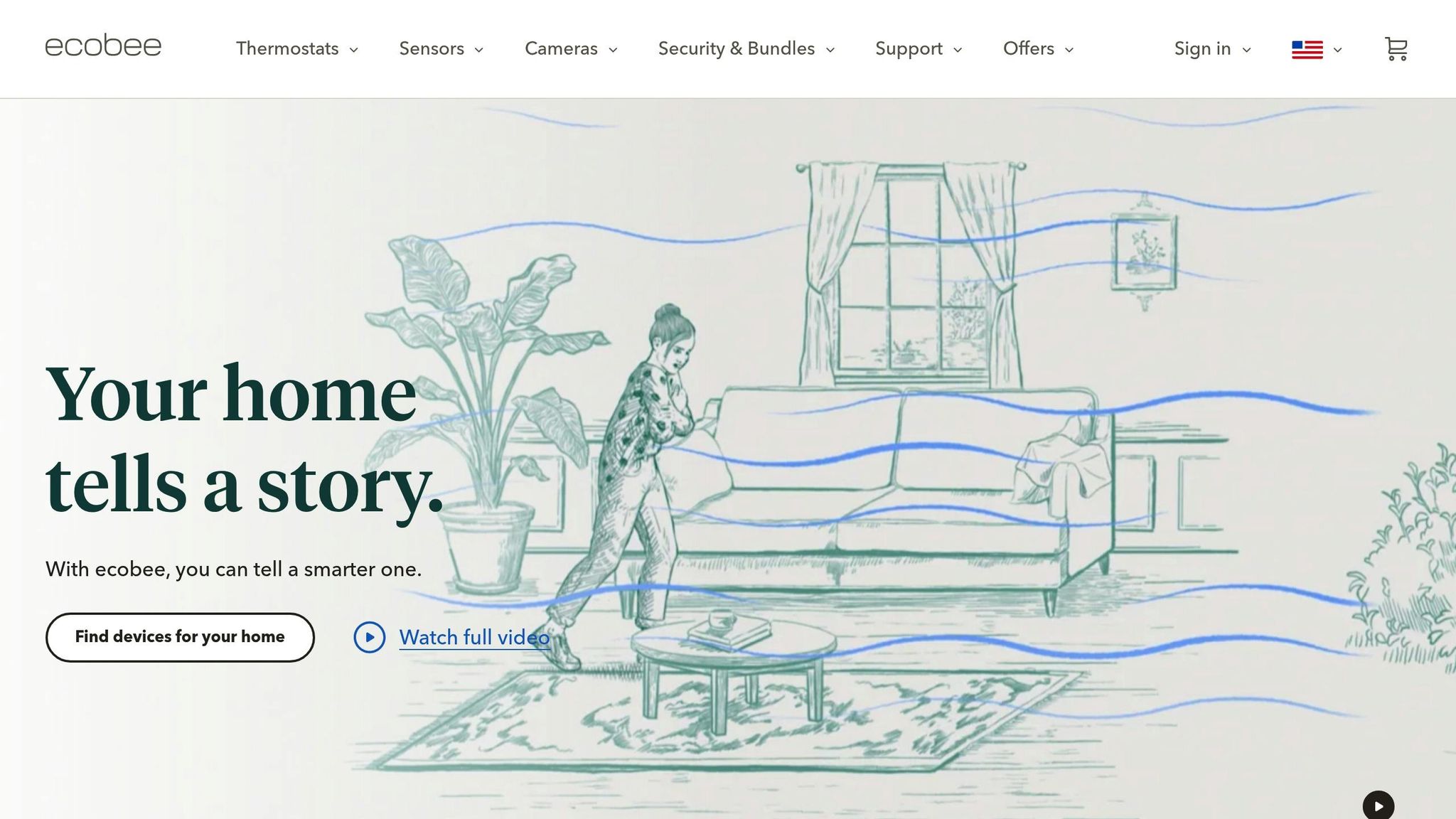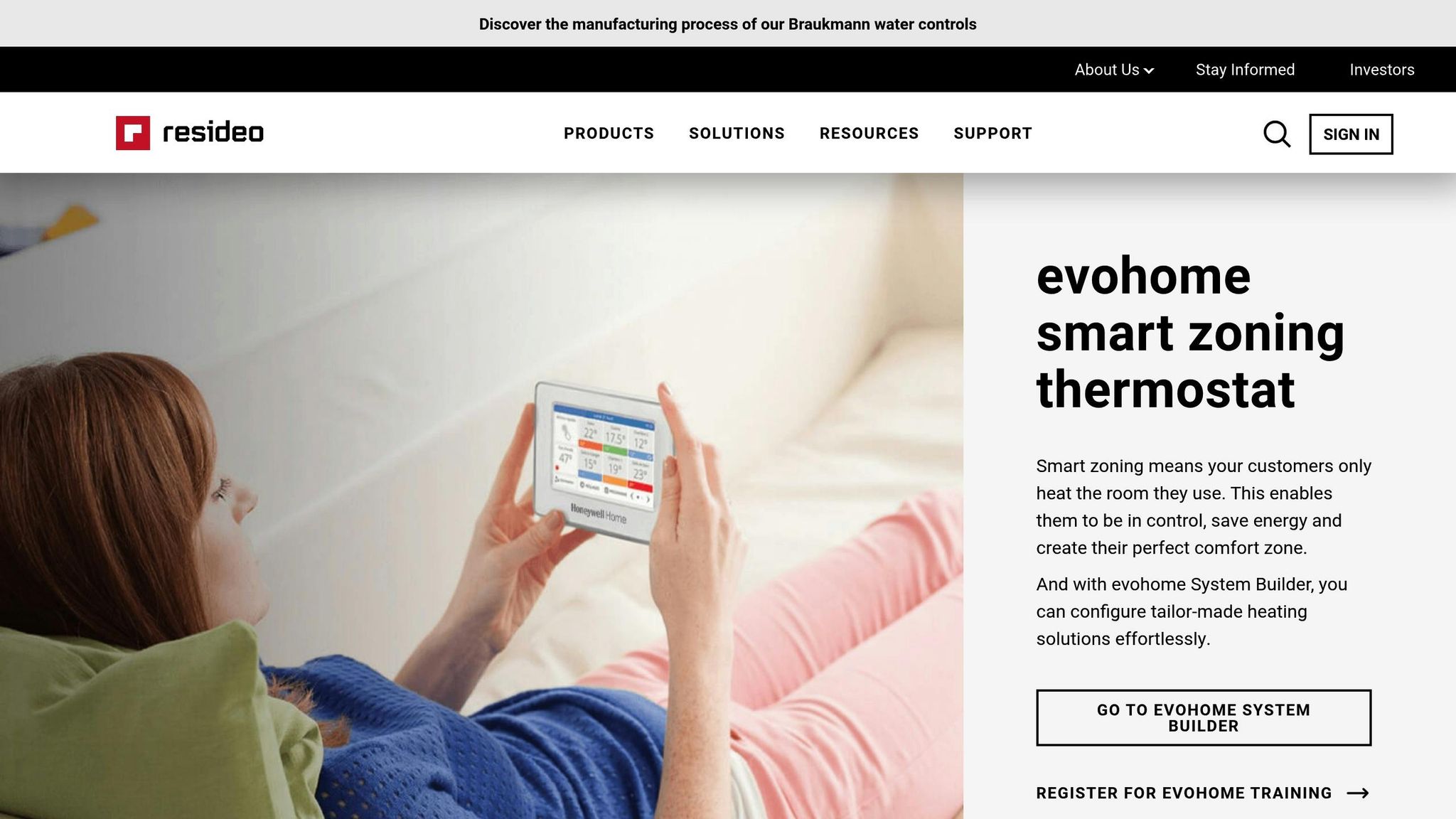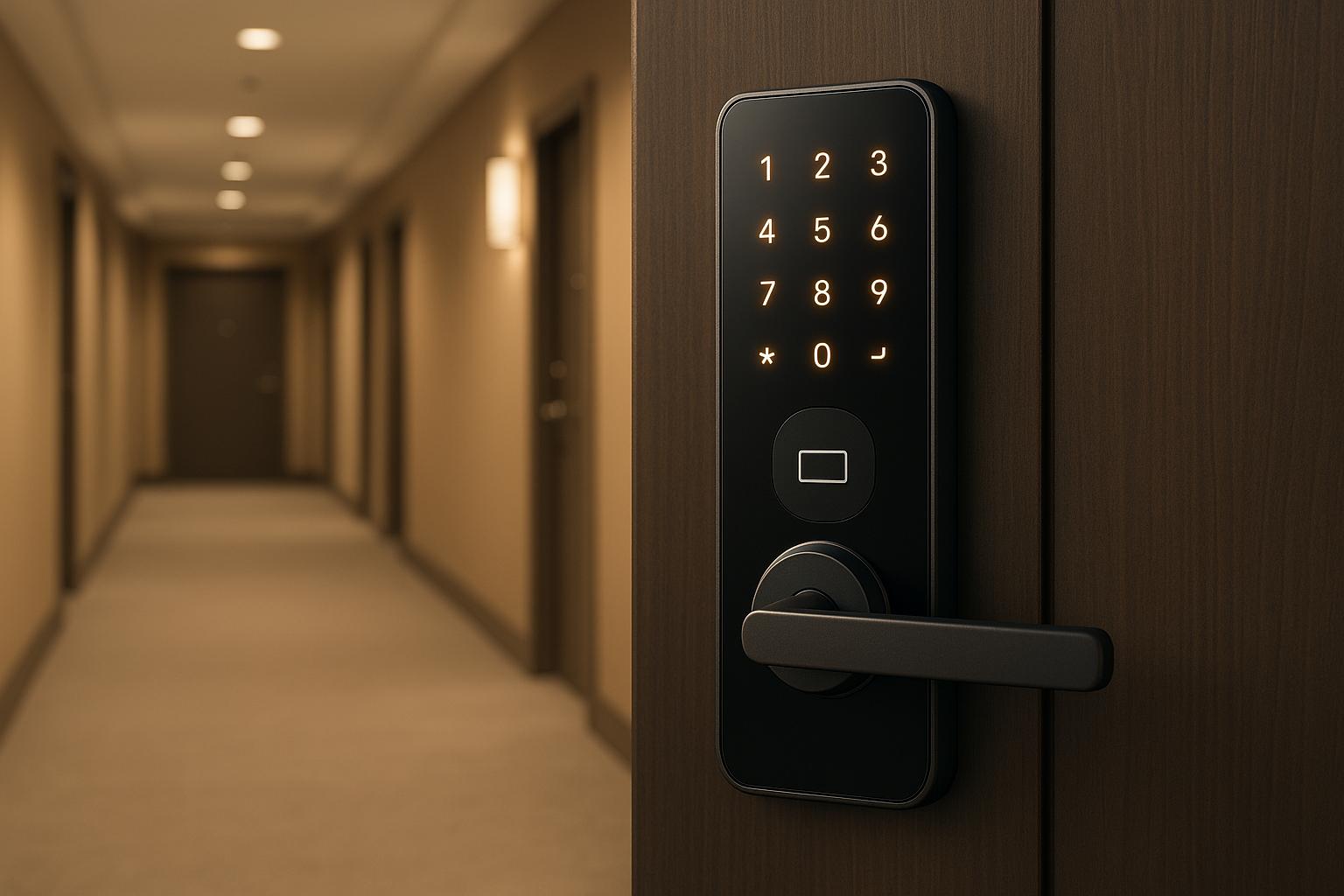Choosing the right smart thermostat for your apartment portfolio can significantly reduce energy costs and improve management efficiency. HVAC systems account for 40–50% of energy expenses, so selecting the right platform is essential. Here's what you need to know:
- Consumer vs. Commercial Options: Nest and ecobee are popular for single-family homes but may not scale well for multifamily properties. Commercial-grade systems like Verdant and NetX are built for bulk installations and centralized control.
- Key Features to Look For:
- Bulk Deployment: Systems should support managing multiple units efficiently.
- Centralized Management: A single platform to monitor and control multiple devices.
- PMS/BMS Integration: Seamless compatibility with property management systems.
- Ease of Use: User-friendly interfaces for both residents and property managers.
- Long-Term Support: Regular updates and scalability for future growth.
Quick Takeaway: Commercial platforms like Verdant and NetX excel in scalability and centralized control. For smaller portfolios, ecobee offers strong integration and usability. Nest is user-friendly but has limitations for large-scale applications.
Comparison Table:
| Platform | Bulk Deployment | Centralized Control | PMS/BMS Integration | Resident Usability | Price Range | Key Limitation |
|---|---|---|---|---|---|---|
| Google Nest | Moderate | Limited | Poor | High | $169–$249 | 10-device account limit |
| ecobee | Good | Good | Good | High | $130–$250 | Requires additional hubs |
| Honeywell Evohome | Good | Good | Good | Moderate | $125–$199 | Requires additional hubs |
| Commercial Providers | Excellent | Excellent | Excellent | Moderate | Varies | Requires specific systems |
Smart thermostats for apartments (smart apartment home automation)
1. Google Nest Learning Thermostat
Google Nest has made strides in the multifamily housing market by offering smart thermostats that adapt to residents' habits. These devices adjust temperatures automatically, helping users save energy. On average, they provide 10% to 12% savings on heating bills and 15% on cooling bills. Since 2011, Nest thermostats have collectively saved an estimated 176,445,520,958 kWh of energy [3].
Bulk Deployment Compatibility
When it comes to large-scale apartment complexes, the Nest Learning Thermostat has its challenges. A single Nest account can manage up to 10 devices across multiple locations [8]. This limitation can complicate things for properties with dozens or even hundreds of units. To work around this, some property managers divide buildings into multiple "homes" within the Nest app. Additionally, the thermostats can be set up to bypass the app and Internet connection after the initial installation, making it easier to manage during tenant move-ins [4].
These deployment considerations directly affect centralized control, which we’ll discuss next.
Centralized Management Features
The Google Home app is the main tool for managing Nest thermostats. It allows users to adjust temperatures and schedules remotely [6]. While this setup is great for individual comfort, it can make managing energy for an entire building a bit more complicated. The app also includes an Eco Temperatures feature, which kicks in when a home is empty and switches back to the usual schedule once residents return [7].
Integration with PMS/BMS
Google Nest has also worked on improving integration with property management systems (PMS) and building management systems (BMS). For example, in August 2024, Google Nest partnered with Minut to sync check-in and check-out schedules with PMS. This allows thermostats to adjust automatically between guest stays [9]. On a larger scale, STRATIS IoT offers a platform that integrates Google Nest thermostats with other smart devices, making it easier to manage multiple units in apartment properties [5].
These integrations are key to ensuring the system can scale effectively for multifamily applications.
Long-Term Support and Scalability
Google has shown a strong commitment to multifamily housing through partnerships with leading property operators. One notable example is a pilot program at Greystar's Denver Parq on Speer, where Nest thermostats were installed in a newly opened high-rise. Plans are in place to expand this deployment to an additional 1,500 units in Denver [5]. With Google's infrastructure and regular software updates, the platform offers reliable long-term support. Additionally, Google Nest prioritizes privacy and security, working with partners who share these values - a crucial consideration as the smart device market is expected to grow to over $3 trillion annually by 2026 [5].
However, the 10-device limit per account remains a scalability challenge for larger portfolios.
2. ecobee Smart Thermostat

ecobee's SmartBuildings platform is designed to simplify energy management for multifamily housing, student accommodations, and senior living facilities. Unlike standard consumer-focused options, this platform addresses the specific needs of property managers who oversee multiple units. Let’s dive into the features that make ecobee an excellent choice for large-scale deployments and centralized control.
Bulk Deployment Compatibility
The SmartBuildings platform eliminates many of the common hurdles associated with deploying smart thermostats in bulk. Property managers can oversee hundreds of devices through a single platform, which supports a range of residential and commercial HVAC systems, including those with multi-speed fans and additional accessories.
Jack in the Box shared, "The ecobee installation was a fast and straightforward process." [10]
For large-scale installations, ecobee’s sales team offers tailored pricing options to meet the needs of property managers.
Centralized Management Features
The platform provides powerful centralized control through both desktop and mobile apps. Features include remote management, real-time monitoring, bulk scheduling, and maintenance alerts. Managers can download up to 15 months of historical data, while strict user authorization settings and tamper-proof controls ensure unauthorized temperature adjustments are avoided.
Resident Usability
ecobee thermostats also prioritize ease of use for residents. Built-in voice control and occupancy-based temperature adjustments help optimize energy savings by lowering temperatures in unoccupied units. In senior living communities, these features allow residents to maintain a comfortable environment while still enabling property managers to maintain centralized oversight.
Integration with PMS/BMS
ecobee’s platform integrates seamlessly with property management systems (PMS) and building management systems (BMS), enhancing its functionality. In March 2025, ecobee partnered with Minut, enabling automatic synchronization with over 25 PMS solutions and Airbnb for short-term rental properties. This integration simplifies climate control across rental portfolios, balancing energy savings with guest comfort. Additionally, ecobee thermostats work with popular smart home systems, including Amazon Alexa, Google Assistant, Apple HomeKit, Samsung SmartThings, and Alarm.com.
Rob Cammalleri, National Account Manager, Builders and Developers at ecobee, stated, "Energy efficiency isn't just important in our own homes, but when we travel too. By automating Smart Thermostats with Minut, we're making it easy for property managers to save energy costs and reduce emissions, without sacrificing time better spent creating incredible experiences for their guests." [12]
Long-Term Support and Scalability
ecobee’s SmartBuildings platform operates on a straightforward subscription model of $2 per thermostat per month, billed annually, making budgeting predictable. The platform has already delivered measurable results; for instance, The Collier Companies achieved a 17% reduction in energy costs using SmartBuildings [10]. The solution has also been recognized for its intuitive design and cost-effectiveness. Superior Automotive Group noted:
"The portal is very intuitive and easy to use, and it's getting better." [10]
With ongoing updates and responsive customer support, ecobee continues to be a dependable partner for property managers looking for scalable and efficient energy management solutions.
3. Honeywell Evohome

The Honeywell Evohome system is a zone-based heating control solution tailored for multifamily properties. Unlike traditional thermostats that manage a single zone, Evohome can handle up to 12 individual heating zones in one property. This makes it ideal for larger units or layouts with complex configurations. By offering precise control over heating and hot water, the system can help reduce household heating costs by up to 40% [14].
Bulk Deployment Compatibility
Evohome’s zone-based design makes it versatile enough to accommodate a variety of property sizes and layouts [14]. Each setup includes an Evohome Controller as the central hub, along with Smart Radiator Thermostats, a Wireless Boiler Relay, Evohome Thermostats, and access to the Evohome App [13]. This modular structure allows property managers to tailor installations to meet the specific heating needs of each unit.
For multifamily properties, this zone-based approach is especially useful. Units with multiple rooms or areas can have customized temperature settings, enabling efficient energy use across all living spaces.
Centralized Management Features
The Total Connect Comfort app takes Evohome’s functionality a step further, offering property managers the ability to oversee multiple thermostats and locations from a single platform [14]. Through this app, managers can adjust temperatures, control heating zones, and monitor system performance remotely [13]. The Evohome Controller itself provides centralized scheduling and monitoring for each zone [13].
This remote management capability is a game-changer for property operators, allowing them to address maintenance needs or make temperature adjustments quickly, all without needing to be on-site.
Integration with PMS/BMS
Evohome also integrates seamlessly with Honeywell’s broader building management ecosystem, making it an attractive option for larger multifamily operations. The Enterprise Buildings Integrator (EBI) unifies HVAC, lighting, fire, and security systems into one cohesive platform [17]. This integration allows for streamlined management and automation across various building systems.
For even broader oversight, Honeywell Forge Performance+ for Buildings offers a cloud-based solution for monitoring and controlling building systems across multiple sites [16]. This approach enables property managers to enhance operational efficiency while addressing safety and energy performance goals [15].
Long-Term Support and Scalability
Honeywell’s systems are designed to grow alongside your needs, making them suitable for both small and expansive facilities [17]. Evohome’s ability to manage up to 12 zones per controller means it can easily accommodate future expansions within a property. Additionally, its integration with Honeywell’s larger building management ecosystem ensures it can scale across multiple buildings, providing a unified technology platform for property managers.
Whether it’s a residential complex, office space, or medical facility, Evohome’s flexibility and scalability make it a practical choice for long-term property management [14].
sbb-itb-58157f8
4. Commercial-Focused Providers
Specialized commercial providers have taken the foundation of traditional platforms and tailored them to meet the demands of large apartment portfolios. These platforms are built with scalability, energy efficiency, and integration in mind, making them ideal for property managers overseeing multifamily properties. Companies like Verdant, NetX, and Pelican have created systems specifically designed to tackle the challenges of deploying smart thermostats across multiple units.
Bulk Deployment Compatibility
One of the standout features of commercial-focused systems is their ability to integrate seamlessly with existing HVAC equipment, enabling large-scale installations. These systems can cut HVAC runtimes by up to 45% [1]. For example, NetX thermostats are capable of reducing HVAC-related energy costs by as much as 30% [18], while the Pelican Smart Thermostat Platform offers the added benefit of qualifying for utility rebates, helping offset initial investment costs [19]. This capability ensures smooth deployment, setting the stage for centralized management.
Centralized Management Features
The real strength of these platforms lies in their centralized control. Property managers can oversee all thermostats across multiple buildings using a single dashboard. This includes features like remote temperature adjustments, setting limits to curb excessive energy use, and generating passcodes to prevent unauthorized changes [11]. These tools offer a streamlined approach to managing energy consumption at scale.
Resident Usability
Even with their commercial focus, these systems don’t overlook the comfort of residents. While property managers retain centralized control, residents are allowed moderate adjustments to maintain a comfortable living environment without compromising energy efficiency. This balance ensures a positive experience for both property managers and tenants.
Integration with PMS/BMS
Just like traditional platforms, commercial solutions are designed to integrate smoothly with Property Management Systems (PMS) and Building Management Systems (BMS). This integration allows for unified control of HVAC, lighting, security, and other building systems through a central interface [21]. Open APIs further enhance compatibility, making it easy to connect with third-party devices and services [20]. For example, GVS Smart’s thermostat system helped their headquarters reduce energy consumption by up to 50% compared to standard setups [20].
Long-Term Support and Scalability
These platforms are built with growth and longevity in mind. They can scale across multiple properties and integrate with existing technologies like property management software and access control systems [23]. Beyond adding more units, they also include predictive maintenance features that identify HVAC issues before they escalate into costly repairs [1]. Verdant clients, for instance, report seeing full returns on investment within 12 to 18 months, with noticeable energy savings emerging just weeks after installation [1]. The growing adoption of such systems is reflected in the U.S. smart thermostat market's projected compound annual growth rate of 17.2%, with an estimated market value of $3.86 billion by 2029 [22].
For property managers, these commercial platforms offer a reliable, scalable solution that aligns with energy-saving goals and long-term operational efficiency. They complement the strategies discussed earlier, creating a cohesive approach to managing multifamily properties efficiently and effectively.
Platform Advantages and Disadvantages
Continuing from our earlier discussion on deployment and control, this section takes a closer look at the strengths and challenges of various smart thermostat platforms. Each platform brings its own set of benefits and hurdles, particularly when applied to apartment portfolios. Here's a breakdown of the key pros and cons for each.
Take Google Nest, for example. It boasts strong brand recognition and an intuitive design, but integrating it into smart building systems can require custom solutions. Its 4th generation Learning Thermostat uses AI to simplify setup, which is a big plus. However, its remote sensors lack presence detection and sometimes need manual adjustments. Pricing starts at $169 for the Thermostat E and goes up to $249 for the 3rd generation model [24][25].
On the other hand, ecobee thermostats shine when it comes to integration with systems like Homebase, which simplifies centralized management. The ecobee Smart Thermostat Enhanced, priced at $187.99, has earned a 4.4-star rating from nearly 3,000 users, thanks to its user-friendly design and precise temperature control [26]. The premium model, priced around $250, offers features like remote SmartSensors and Alexa voice control. However, setup can be more complex, and some users report challenges with customer support. Additionally, most ecobee models require extra hubs, which can complicate large-scale installations [24][25].
Honeywell systems are known for balancing affordability with functionality. The Honeywell T6 Pro, available wholesale for $125–$200, and the T9, retailing at about $199, offer solid integration with smart building systems. However, like ecobee, they also require separate hubs, which adds to the installation process [24].
For larger, commercial-focused providers, the advantages are clear where consumer platforms fall short. These systems often include embedded hub technology, such as LoRaWAN, which simplifies installation and maintenance. They also excel at centralized control and integrate seamlessly with property management (PMS) and building management systems (BMS). That said, they often require specific smart building operating systems, which can limit flexibility [24].
Here's a quick comparison of the platforms:
| Platform | Bulk Compatibility | Centralized Control | Resident Usability | PMS/BMS Integration | Price Range | Key Limitation |
|---|---|---|---|---|---|---|
| Google Nest | Moderate | Limited | High | Poor | $169–$249 | Integration challenges |
| ecobee | Good | Good | High | Good | $130–$250 | Requires additional hubs |
| Honeywell | Good | Good | Moderate | Good | $125–$199 | Requires additional hubs |
| Commercial Providers | Excellent | Excellent | Moderate | Excellent | Varies | Requires specific building systems |
Cost considerations go beyond the sticker price. Smart thermostats have the potential to cut heating and cooling costs by at least 8% annually, with some estimates reaching as high as 26% [25]. However, platforms requiring additional hubs can drive up both upfront costs and ongoing maintenance expenses. Property managers need to weigh these factors against the potential energy savings and operational efficiencies.
Usability differences also play a big role in tenant satisfaction. A study revealed that 51% of users preferred controlling their thermostats through smartphone apps [27]. Platforms with easy-to-use interfaces and dependable mobile apps often lead to fewer maintenance requests and happier residents.
The best choice ultimately depends on factors like portfolio size, existing infrastructure, and management goals. Smaller portfolios might prioritize systems that are simple and user-friendly, while larger operations may lean toward commercial solutions that offer centralized management and deeper PMS/BMS integration.
Conclusion
Selecting the right smart thermostat platform for your apartment portfolio comes down to aligning your specific needs with the strengths of each platform to ensure effective implementation.
For larger-scale deployments, platforms designed for commercial use offer centralized control and smooth integration with existing systems. These features not only simplify management but also boost resident interest, which can translate into financial gains for property owners.
Resident satisfaction is a key consideration as well. Studies show that 72% of renters view smart thermostats as an essential feature, emphasizing the importance of intuitive, user-friendly designs [30]. Platforms like Google Nest and ecobee stand out in this area. Data reveals that renters are willing to pay an additional $37.65 per month for smart home technology, while properties that adopt smart features report a 23% rise in resident satisfaction [29][31].
Integration is another critical factor. Solutions such as ecobee's SmartBuildings system simplify property management and improve operational efficiency, often leading to noticeable energy savings [10]. These capabilities not only streamline day-to-day operations but also enhance tenant experiences, creating a win-win situation for both residents and property managers.
The financial benefits of smart thermostats are undeniable. 95% of multifamily decision-makers believe the investment pays off, with many systems achieving consistent energy savings of 15%–20% [2][28]. While consumer-grade options focus on improving the resident experience, commercial platforms deliver the centralized control necessary for managing larger portfolios effectively.
FAQs
Why should I choose a commercial-grade smart thermostat platform for managing a large apartment portfolio?
Commercial-grade smart thermostat platforms are tailored for the demands of large-scale properties. They offer centralized controls, enabling property managers to oversee multiple units effortlessly from a single system. These platforms also work with occupancy sensors to fine-tune energy usage, helping lower costs across an entire property portfolio.
What sets commercial platforms apart from consumer-grade options is their ability to handle scalability. They integrate seamlessly with property management systems (PMS) and building management systems (BMS), ensuring smoother day-to-day operations and dependable long-term performance. This makes them an ideal choice for multifamily properties looking for efficiency and reliability.
How do smart thermostats benefit from integrating with Property Management Systems (PMS) and Building Management Systems (BMS) in multifamily properties?
Smart thermostats, when connected to Property Management Systems (PMS) and Building Management Systems (BMS), bring a new level of efficiency and convenience to property management. These integrations make it easier to manage operations while also enhancing the experience for tenants.
With this setup, property managers can centralize control over heating and cooling systems, automate energy settings based on occupancy, and keep an eye on HVAC performance in real time. This not only helps cut down on energy costs but also ensures optimal comfort for residents.
By syncing with PMS and BMS, smart thermostats can adjust temperatures automatically, aligning with tenant schedules and building needs. On top of that, they deliver valuable data and insights that help property managers make smarter decisions, all while maintaining a comfortable and energy-efficient environment.
What should property managers look for in a smart thermostat platform to ensure it supports long-term growth and reliability?
When choosing a smart thermostat platform, property managers should focus on how well it works with their current systems, such as property management software (PMS) and building management systems (BMS). Compatibility is key to ensuring everything runs smoothly without unnecessary disruptions.
It's also worth looking into whether the platform is built to handle updates and upgrades. This flexibility is important to keep up with changing technology and the growing demands of your property portfolio.
Another critical factor is the vendor's level of support. Reliable customer service, consistent updates, and a strong cloud infrastructure are essential for keeping the platform efficient, scalable, and trustworthy as your needs evolve.


